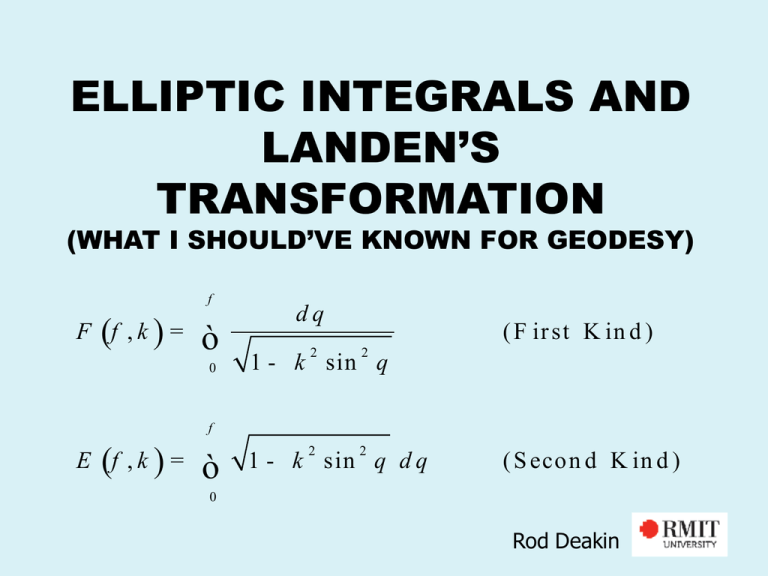
ELLIPTIC INTEGRALS AND
LANDEN’S
TRANSFORMATION
(WHAT I SHOULD’VE KNOWN FOR GEODESY)
f
F (f , k ) =
ò
0
dq
( F ir st K in d )
2
2
2
2
1 - k sin q
f
E (f , k ) =
ò
1 - k sin q d q
( S econ d K in d )
0
Rod Deakin
What’s so special about elliptic integrals
They crop up in geodetic problems:
• Meridian distance on an ellipsoid.
• Geodesic arc length.
• Transverse Mercator projection coordinates.
They cannot be evaluated in closed form
by elementary methods.
They may be approximated by:
• Series expansion and term-by-term
integration. (usual method - not bad)
• Landen’s transformation. (simple and very
clever!)
Who was Landen?
John Landen (1719–1790) was an English land
surveyor (20 years) and then the Earl
Fitzwilliam’s land agent (26 years). Also an
amateur mathematician.
Published 8 articles in Philosophical Transactions of
the Royal Society between 1754 and 1785 and
elected a fellow in 1766.
Also published 8 books and contributed problems
and solutions to the Ladies Diary (a publication
designed principally for the amusement and
instruction of the fair sex)
Landen’s transformation
Landen’s contribution to mathematics was to
show how an arc of an hyperbola could be
expressed as the sum of two arcs of auxiliary
ellipses. He did this by using an algebraic
transformation of fluents (integrals).
A.M. Legendre (1752–1833) developed Landen’s
work and expressed his transformation in
trigonometric form as:
sin (2 f
n+1
- f
n
)=
k n sin f
n
a n d kn + 1 =
2 kn
1 + kn
Evaluating F (f 0 , k 0 )
Legendre then used Landen’s transformation in
the following way:
f
If
F (f 0 , k 0 ) =
0
dq
ò
2
and
t h en
sin (2 f
n+1
- f
F (f 0 , k 0 ) =
=
n
)=
2
1 + k0
2
k n sin f
2
1 + k0
2 kn
a n d kn + 1 =
n
1 + kn
F (f 1 , k 1 )
×
1 + k0
=
2
1 - k 0 sin q
0
2
1 + k1
×
2
1 + k1
F (f 2 , k 2 )
×
2
1 + k2
L
2
1 + kn- 1
F (f n , k n )
As n the sequence of k n converges to
unity and the sequence of f n converges to
a limiting value, and
F (f 0 , k 0 ) »
k 1k 2 k 3 L k n
k0
ln t a n ( 14 p +
1
2
f
The sequences converge in only a few
iterations
n
)
Iterative scheme
An example of the iterative scheme for the
evaluation of F ( 13 p , 0.08 )
n
0
1
2
3
4
5
6
7
n (degrees)
kn
0.080000000000000000000000000000
0.523782800878924092148773601559
0.949910187049589210997543775191
0.999670002027321953622743219568
0.999999986383174006610440236550
0.999999999999999976822755917618
1.000000000000000000000000000000
1.000000000000000000000000000000
k 1k 2 k 3 L k 7
60.000000000000000000000000000000
31.986375290275345206426642287209
24.047430982645159265462549335921
23.410227894528127n587073492551888
23.406135016316805818730472567793
23.406134847458754170823337386119
23.406134847458753883409497070244
23.406134847458753883409497070244
= 2.493447468386180336582176623321
k0
f
ln t a n ( 14 p +
7
)
F ( p , 0.08 )
1
3
1
2
f
7
= 23.406134847458753883409497070244 d egr ee s
= 0.420374825518291193367606198921
» 1.04818254446186545539848353357 1
Computer code
Maxima code for the evaluation of an elliptic
integral of the First Kind
F(phi,k) := block([product : 1/k, tol : 1.0b-36],
while (1-k) > tol do block(
phi : (asin(k*sin(phi))+phi)/2,
k : 2*sqrt(k)/(1+k),
product : product*k),
return(sqrt(product)*log(tan(pion4+phi/2))))
Evaluating E (f 0 , k 0 )
Legendre used Landen’s transformation to express
and elliptic integral of the Second Kind in the
following way:
f
If
0
ò
E (f 0 , k 0 ) =
2
2
1 - k 0 sin q d q
0
and
sin (2 f
E (f 0 , k 0 ) =
1
- f
(1 +
0
)=
k 0 sin f
0
a n d k1 =
2 k0
t h en
1 + k0
k 1 ) E (f 1 , k 1 ) + (1 - k 0 ) F (f 0 , k 0 ) - k 0 sin f
0
After some manipulation a formula using the
Arithmetic-Geometric Mean (AGM) sequence can
be obtained as:
ìï 2 1 a c + 2 2 a c + 2 3 a c ü
ï
1 1
2 2
3 3ï
ï
E (f 0 , k 0 ) » F (f 0 , k 0 ) í 4
ý
ï 2 a c + L + 2n a c
ï
ïïî
ïïþ
4 4
n n
ìï 2 0 g sin f + 2 1 g sin f + 2 2 g sin f ü
ï
ï
0
0
1
1
2
2ï
- í
ý
ï + 2 3 g sin f + L + 2 n - 1 g
sin f n - 1 ïï
ïîï
3
3
n- 1
ï
þ
n
+ 2 a n sin f n
w h er e a n + 1 =
1
2
(a
n
+ g n ), g n + 1 =
a n gn , cn + 1 =
1
2
(a
n
- gn
)
Arithmetic-Geometric Mean (AGM)
For two positive real numbers a , b with a > b
put a 0 = a , g 0 = b then with
an+ 1 =
1
2
(a n + g n ), g n + 1 =
a n gn , cn + 1 =
1
2
(a
n
- gn
The sequences a n , g n converge to a common
limit M (a , b ) and c n converges to zero.
n
an
0 100.000000000000000000000000000000
1 50.500000000000000000000000000000
2 30.250000000000000000000000000000
3 26.361102527122115932299070222745
4 26.216887049460483910562429431797
5 26.216688720600012389832846351910
6 26.216688720224923669479049585065
7 26.216688720224923669477707963039
gn
1.000000000000000000000000000000
10.000000000000000000000000000000
22.472205054244231864598140445491
26.072671571798851888825788640849
26.216490391739540869103263272023
26.216688719849834949125252818220
26.216688720224923669476366341013
26.216688720224923669477707963039
cn
49.500000000000000000000000000000
20.250000000000000000000000000000
3.888897472877884067700929777255
0.144215477661632021736640790948
0.000198328860471520729583079887
0.000000000375088720353796766845
0.000000000000000000001341622026
)
Computer code
Maxima code for the evaluation of an elliptic
integral of the Second Kind
E(phi,k) := block([a : 1.0b0, g : k, n : 0,
sum1 : 0.0b0, sum2 : 0.0b0, tol : 1.0b-36],
F : F(phi,k),
while (a-g) > tol do block(
sum2 : sum2 + (2^n)*g*sin(phi),
a1 : (a + g)/2,
g1 : sqrt(a*g),
c1 : (a - g)/2,
phi : (asin(k*sin(phi))+phi)/2,
sum1 : sum1 + (2^(n+1))*a1*c1,
a : a1,
g : g1,
k : g1/a1,
n : n+1),
return(F*sum1-sum2+(2^n)*a*sin(phi)))
Meridian distance (series formula)
ìï c f
ï 0
ï
ï
a ïï
M =
í
1 + n ïï
ï
ï
ïï
î
c0 = 1 +
1
4
n
2
+
1
64
n
4
+
üï
ï
ï
ï
+ c 6 sin 6 f + c 8 sin 8 f
ïï
ý
ï
+ c 10 sin 10 f + c 12 sin 12 f
ï
ï
+ c 14 sin 14 f + c 16 sin 16 f + L ïï
ïþ
+ c 2 sin 2 f + c 4 sin 4 f
1
n
6
+
25
8
n L
256
16384
15 2
15 4
75
105 8
6
c4 =
n n n n - L
16
64
2048
8192
315 4
441 6
1323 8
c8 =
n n n - L
512
2048
32768
1 001 6
1573 8
c 12 =
n n - L
2048
8192
109395 8
c 16 =
n - L
262144
c2 = c6 = c 10
c 14
3
n +
2
35
3
n
3
16
n
48
693
3
+
3
+
n
5
15
+
128
175
n
5
+
n
2048
245
n
768
6144
2079 7
5
= n +
n + L
1280
10240
6435 7
= n + L
14336
7
+ L
7
+ L
Meridian distance (Elliptic integral)
ìï
ïï
M = a í E (f , e ) ï
ïîï
a
flat
f
phi
e
E(phi,e)
mdist
ü
2
e sin f cos f ïïï
ý
2
2
1 - e sin f ïïþ
ï
= 6378137.000000000000000000000000000000 metres
=
298.257222101000000000000000000000
=
0.003352810681182318935434146126
=
60.000000000000000000000000000000(degrees)
=
0.081819191042815790145895739896
=
1.046168817527900319688127443142
= 6654072.819367444406819108934413675127 metres
More on Landen
John Landen was one of a
group of non-academic men
fully employed in the
ordinary businesses of life,
but keenly and intelligently
interested in scientific
matters.
He was the eldest of three
sons born to parents of
yeoman stock.
John Landen (1719–1790)
He was well educated and his chosen
profession of surveying demanded
independently minded people able to gather
information, analyse problems and provide
solutions. He was an accomplished
mathematician and read extensively in both
French and Latin.
He apparently had little tolerance for people
he disagreed with and his dogmatism and
pugnacity caused him to be generally
shunned in polite society.
But he must have had a sense of humour.
His pseudonyms in the Ladies Diary were
Sir Stately Stiff, C. Bumpkin and Peter
Puzzlem (and others).
THE END










